Dorothea Tanning (2019): ‘Her Life in Artworks’ – Art Review
Introduction
It feels as if Surrealism is getting a bit of a resurgence in the art world with exhibitions like Dalí/Duchamp, Man Ray Exhibition at the National Portrait Gallery and, again, Dorothea Tanning: Web of Dreams popping up. But along with the resurgence some artists are finally getting some much-deserved attention. These artists are typically female and had been usually overshadowed by their male counterparts and husbands. One such example is Dorothea Tanning. Married to Max Ernst may have been a blessing and a curse all at once. Influencing and helping her career, but always leaving her behind him, for the most part. It is a real shame, as many of her paintings show some real complexity, whilst making some important comments on the nature of Surrealism. In her book Angels of Anarchy: Women Artists and Surrealism, Patricia Allmer posits that, amongst other things, these artists are connected by some visual motivs, including the use of the domestic space and Self-Portraiture. This Exhibition at the Tate Modern looks to be a great retrospective of the artists’ life and works, breaking new ground in bringing her artworks to a mass audience.
A Look at Her Life’s Work
Sectioned into time periods, this exhibition has paintings from different periods of Dorothea Tanning’s life. Interestingly expanding into her later life work with sculptures and installations using stitching, whilst also including a brief documentary about the artist for a more thorough overview of her life. This gave the Dorothea Tanning exhibition more of a presence, whilst expanding her work into more of a variety of interesting visual aspects of her life than being just kept restricted to her paintings. Whilst most of her fame includes paintings such as Eine Kleine Nachtmusik (1943), Birthday (1942) and Tableau Vivant (1954), the exhibition makes sure to include some of these with a more thorough mixture of less famous works, some going as far as personal sketches, studies and photographs. This gives a more complete picture of her life in art but may disappoint those wishing to see the more notable pieces.
The Domestic Dorothea Tanning
Comparing the artworks, there are some noteworthy similarities and motivs, some in line with Patricia Allmer’s position, whilst others not so much. Dorothea Tanning had a particular fascination with Doors and odd and imaginative fashion, whilst her later work broke into what could be done with sewn sculptures. These are aspects of typical domestic spaces or works associated with such, but to limit them to this would be missing the point. Each shows a dreamlike logic that expands itself beyond the restriction of these areas. The doors are often a way of creating more space, or limiting space, beyond what is typically understood within the domestic area. This allows Surrealism to reflect things as contained and open, barriers but passive, all at once.
Similarities to Other Artists
The presence of Max Ernst is here as depicted in one painting and referred to briefly in the documentary, but mostly within later works of paintings that incorporate textures within them. Though the influence is there, it feels more fragmented and more in line with the way in which her abstract paintings take the Surreal duality of objects, beings and people into a multiplicity, like an ink blot test. Allowing instead for the observer to see one and many things within them. Additionally, and similar to Leonor Fini’s sphinxes or cats, Dorothea Tanning also holds the presence of a dog within her works. Much like an all wise being imposing onto, into and out of each painting. The similarity is interesting but reflects, much like the absent Tableau Vivant (1954) but also in paintings like Reality (1973-83) and Un tissu de songes (1973-93), the power that beings can have over us, even if they are typically powerless.
Conclusion
Dorothea Tanning is an important figure within Surrealism for the dual role of figures, objects and spaces; but this carries over into Women Artists and also the art world as a whole. Identifying her as the wife of Max Ernst is restricting, so is seeing her as a female artist or a Surrealist. Her works are expansive and show a keen interest in many things that make strong comments on Surrealism but also how art functions. The textures and installations manage to break free from the two dimensional aspects of painting and redefine material in other ways that could be more of a Dadaistic influence than a Surrealist one. The multiplicity of figures, objects and spaces start within the dreamlike nature of surrealism and continues to comment on this as it expands throughout her life but begins to evolve into Abstract Art and different means of representation beyond these initial interests. The exhibition, though limited, helps to expand upon a figure personally and progressively through her life; allowing her art to evolve before our eyes.
Dorothea Tanning was shown at the Tate Modern from 27th February 2019 until June 9th.
Further Reading
Dorothea Tanning at the Tate Modern
Some Striking Femenine Anger – A Review
The Art Story Dorothea Tanning
If you liked this…
Dorothea Tanning – Web Dreams 2014 – Art Review
Francesca Woodman – Zig Zag 2014 – Art Review
Dalí/Duchamp 2017 – Art Review
Man Ray, Exhibition at National Portrait Gallery – Art Review
See a selected list of works below:
- Dorothea Tanning. Birthday, 1942.
- Dorothea Tanning. Hôtel-du Pavot Chambre 202 (Poppy Hotel, Room 202) 1970-73, mixed media
- Dorothea Tanning. Reality, 1973-83.
- Dorothea Tanning. Un tissu de songes, 1973-93.
- Dorothea Tanning. Chiens de Cythère (Dogs of Cythera) (1963) Oil on canvas
- Dorothea Tanning. Eine Kleine Nachtmusik, 1943,
- Dorothea Tanning. The Guest Room (1950-52) Oil on canvas
- Dorothea Tanning. Nue couchée, 1969-70.
- Dorothea Tanning. Notes for an Apocalypse, 1978.

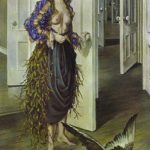

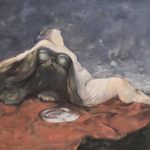
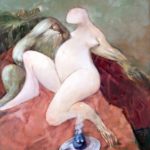
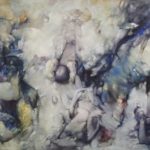
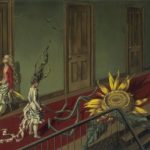

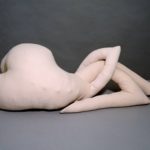
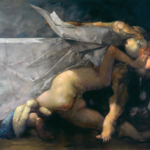






Leave a Reply